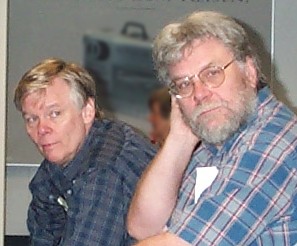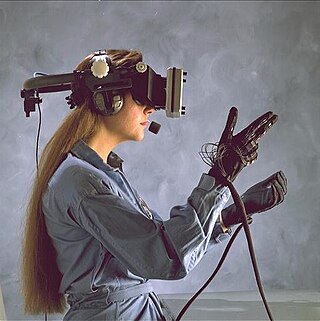Related Research Articles

Virtual reality (VR) is a simulated experience that employs 3D near-eye displays and pose tracking to give the user an immersive feel of a virtual world. Applications of virtual reality include entertainment, education and business. VR is one of the key technologies in the reality-virtuality continuum. As such, it is different from other digital visualization solutions, such as augmented virtuality and augmented reality.

In the industrial design field of human–computer interaction, a user interface (UI) is the space where interactions between humans and machines occur. The goal of this interaction is to allow effective operation and control of the machine from the human end, while the machine simultaneously feeds back information that aids the operators' decision-making process. Examples of this broad concept of user interfaces include the interactive aspects of computer operating systems, hand tools, heavy machinery operator controls and process controls. The design considerations applicable when creating user interfaces are related to, or involve such disciplines as, ergonomics and psychology.
The Aspen Movie Map was a hypermedia system developed at MIT that enabled the user to take a virtual tour through the city of Aspen, Colorado. It was developed by a team working with Andrew Lippman in 1978 with funding from ARPA.

Telepresence is the appearance or sensation of a person being present at a place other than their true location, via telerobotics or video.

Telerobotics is the area of robotics concerned with the control of semi-autonomous robots from a distance, chiefly using television, wireless networks or tethered connections. It is a combination of two major subfields, which are teleoperation and telepresence.
Artificial Reality is a book series by Myron W. Krueger about interactive immersive environments, based on video recognition techniques, that put a user in full, unencumbered contact with the digital world. He started this work in the late 1960s and is considered to be a key figure in the early innovation of virtual reality. For 16 years Krueger was creating a computer system that connected the actions of a user to the real-time response of visual and auditory displays. Artificial Reality was published in 1983 and updated in Artificial Reality II in 1991. Artificial Reality II was to explore the concept of 'Videoplace', which is when a users body is implemented into a computer created world full of color, sound, and visuals. Whilst the first iteration of the series Artificial Reality has laid the ground work for different branches of computer-generated worlds like Virtual Reality and Augmented Reality. Visualization is key for all artificial realities to efficiently use data; resulting in being able to utilize human sensory systems that create these artificial realities.

Myron Krueger is an American computer artist who developed early interactive works. He is also considered to be one of the first generation virtual reality and augmented reality researchers.

A wired glove is an input device for human–computer interaction worn like a glove.
Strictly, digital theatre is a hybrid art form, gaining strength from theatre's ability to facilitate the imagination and create human connections and digital technology's ability to extend the reach of communication and visualization.
The Sword of Damocles is widely misattributed as the name of the first AR display prototype. According to Ivan Sutherland, this was merely a joke name for the mechanical system that supported and tracked the actual HMD below it. It happened to look like a giant overhead cross, hence the joke. Ivan Sutherland's 1968 ground-breaking AR prototype was actually called "the head-mounted display", which is perhaps the first recorded use of the term "HMD", and he preferred "Stereoscopic-Television Apparatus for Individual Use."
The Electronic Visualization Laboratory (EVL) is an interdisciplinary research lab and graduate studies program at the University of Illinois at Chicago, bringing together faculty, students and staff primarily from the Art and Computer Science departments of UIC. The primary areas of research are in computer graphics, visualization, virtual and augmented reality, advanced networking, and media art. Graduates of EVL either earn a Masters or Doctoral degree in Computer Science.

Rebecca Allen is an internationally recognized digital artist inspired by the aesthetics of motion, the study of perception and behavior and the potential of advanced technology. Her artwork, which spans five decades and takes the form of experimental video, large-scale performances, live simulations and virtual and augmented reality art installations, addresses issues of gender, identity and what it means to be human as technology redefines our sense of reality.

In virtual reality (VR), immersion is the perception of being physically present in a non-physical world. The perception is created by surrounding the user of the VR system in images, sound or other stimuli that provide an engrossing total environment.
Presence is a theoretical concept describing the extent to which media represent the world. Presence is further described by Matthew Lombard and Theresa Ditton as “an illusion that a mediated experience is not mediated." Today, it often considers the effect that people experience when they interact with a computer-mediated or computer-generated environment. The conceptualization of presence borrows from multiple fields including communication, computer science, psychology, science, engineering, philosophy, and the arts. The concept of presence accounts for a variety of computer applications and Web-based entertainment today that are developed on the fundamentals of the phenomenon, in order to give people the sense of, as Sheridan called it, “being there."
In computing, 3D interaction is a form of human-machine interaction where users are able to move and perform interaction in 3D space. Both human and machine process information where the physical position of elements in the 3D space is relevant.
In computing, a natural user interface (NUI) or natural interface is a user interface that is effectively invisible, and remains invisible as the user continuously learns increasingly complex interactions. The word "natural" is used because most computer interfaces use artificial control devices whose operation has to be learned. Examples include voice assistants, such as Alexa and Siri, touch and multitouch interactions on today's mobile phones and tablets, but also touch interfaces invisibly integrated into the textiles of furniture.
uSens, Inc. is a Silicon Valley startup founded in 2014 in San Jose, California. The company builds interactive computer-vision tracking solutions. The uSens team has extensive experience in artificial intelligence (AI), computer vision, 3D Human–computer interaction (HCI) technology and augmented reality and virtual reality. uSens has been applying computer vision and AI technologies in AR/VR, Automotive and smartphones.

A virtual reality game or VR game is a video game played on virtual reality (VR) hardware. Most VR games are based on player immersion, typically through a head-mounted display unit or headset with stereoscopic displays and one or more controllers.
Steven Mark Drucker is an American computer scientist who studies how to help people understand data, and communicate their insights to others. He is a partner at Microsoft Research, where he also serves as the research manager of the VIDA group. Drucker is an affiliate professor at the University of Washington Computer Science and Engineering Department.
Cinematic virtual reality (Cine-VR) is an immersive experience where the audience can look around in 360 degrees while hearing spatialized audio specifically designed to reinforce the belief that the audience is actually in the virtual environment rather than watching it on a two-dimensional screen. Cine-VR is different from traditional Virtual Reality which uses computer generated worlds and characters more akin to interactive gaming engines, while cine-VR uses live images captured thorough a camera which makes it more like film.
References
- Kalawsky, R. S. (1993). The science of virtual reality and virtual environments : a technical, scientific and engineering reference on virtual environments, Addison-Wesley, Wokingham, England ; Reading, Mass
- Rheingold, H. (1992). Virtual reality, Simon & Schuster, New York, N.Y.
- Sturman, D. J., and Zeltzer, D. (1994). “A Survey of Glove-based Input.” IEEE Computer Graphics and Applications, 14(1), 30
- Fails, Jerry Alan and Olsen, Dan R. (2003). "Interactive Machine Learning." ACM Proceedings of the 8th international conference on Intelligent user interfaces, pp. 39 - 45